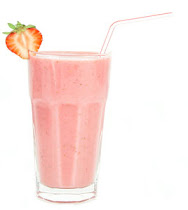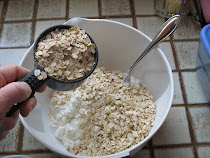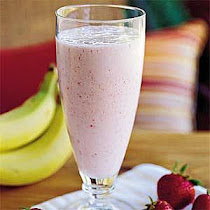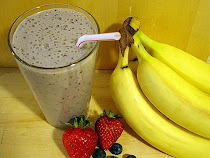Homemade Protein Shakes Recipe 2
1 cup strawberries
½ cup of orange juice
1 cup low fat yogurt, vanilla flavor
1½ cups skim milk
2 scoops whey protein powder
1 tbsp honey
Place all the ingredients in a blender and blend until smooth.
Homemade Protein Shakes Recipe 1
8 oz skim milk
1 tbsp peanut butter
1 banana
2 scoops of whey protein powder
Put all the ingredients in a blender and blend until smooth. And there you have it, a delicious homemade protein shakes drink.
Although many women avoid lifting heavy weights because they are afraid they’ll get bigger, many men who want to build bulk know that it's not easy to build muscle. The secret to getting buff boils down a simple recipe: Lift heavy weights two to three times a week, and eat more calories than normal. (Having shorter arms and legs and a genetic tendency to build muscle also helps.)
If you intend to recognize the best exercises to lose weight, the exercise stimulus creates a sort of muscle breakdown so that when you sleep, your muscles go into an anabolic state to get bigger and stronger than before. Consuming extra calories provides the energy needed for this rebuilding process.
Many people believe that you need to eat more protein than normal to fuel muscle growth, but this is not really true for most weight lifters, according to research by Peter Lemon, a renowned protein researcher and professor at the University of Western Ontario in Canada.
The recommended daily allowance (RDA) for protein that the average person should get in their daily diet is .8 grams for every kilogram of body weight. Lemon’s research shows that exercisers need between .8 grams and 1.7 grams per kilogram of body weight. Some bodybuilders take in four or five times as much as the RDA—and, according to this research, totally unnecessarily.
Extra protein does not automatically make extra muscle. In fact, if you eat more protein than your body uses, it will be stored as fat. So, bodybuilders who down six chicken breasts at time in between high-protein shakes and bars may be adding more to their waistline than their biceps.
Protein shake can add as much as 200 grams or 300 grams of protein (800 to 1,200 calories) a day. If you don’t need it, the body stores all those extra calories as fat. Also, if these shakes are taking you to the high end of the protein spectrum, you may be increasing health risks—high-protein diets may cause bone loss and kidney damage.
There is some debate about the types of protein in different protein shakes or supplements. But the bottom line is, you probably don’t need added protein. And even if you do, it’s probably healthier to get it from real foods, not processed supplements.
An easy way to calculate your needs is to multiply .36 by your body weight in pounds. So if you weigh 180 pounds, you need about 65 grams of protein per day, or about 47 grams per day if you weigh 130 pounds.
If you consider that the average chicken breast may contain 30 grams to 60 grams of protein, one slice of cheddar cheese has 7 grams, and even one cup of chopped broccoli has about 5 grams of protein—it’s very easy to get what you need from the meals and snacks in your day without making an extra effort. In fact, the average American takes in around 100 grams of protein a day.
Beginning weight-lifters trying to build muscle need a little more protein than the RDA. If you are extremely active—such as an endurance exerciser going on long runs, for example—you may need about 50 percent more than the RDA, or 1.2 grams of protein powder per kilogram of body weight, but for a 135-pound woman that’s still only about 70 grams per day.
So while certain exercisers may need more protein, chances are, you are getting more than enough already. It's unlikely that even a novice weightlifter will need to supplement over what they are already eating.
When you drink protein drinks—and when you eat more carbs—may be more important than how much and what type of protein you eat. After a hard workout, even though you feel ready to quit, your body isn’t: The muscle-building process is about to begin. Your body is most primed to refuel starting about 45 minutes after you work out, up to about two hours. So it’s time to eat—ideally, carbs with a touch of protein.
In this post-workout period, muscles are most highly sensitive to insulin—and eating triggers the release of insulin. And since insulin helps shuttle the carbs—or glucose—that you eat into cells, higher levels mean that more glucose gets in. Plus insulin activates an enzyme that specifically helps store extra glucose in your muscles. That means your muscles are better fueled for tomorrow’s workout. More insulin also helps trigger protein synthesis. So if you fuel up post-workout, muscles will pack more protein powders into your muscle’s fibers.
Research shows that your post-workout snack should consist of as much as four times as much carbs to protein, or a 2-to-1 to 4-to-1 ratio, according to John Ivy, a professor of kinesiology at the University of Texas at Austin and the author of Nutrient Timing. So after a hard workout, eat a carb- and protein shakes. (Some people don’t feel like eating right after a hard session, so here’s where having a shake or a protein-supplemented energy drink may be useful.) Foods to nibble on include a handful of almonds, walnuts, peanuts, pecans, sunflower seeds, peanut butter on bread, vegetables and fruit with yogurt.
Related Post:
Related post
1. Three Classic Homemade Protein Shakes
2. Protein Shakes Exclusive Recipes
3. Trendy Meal Replacement Shakes
4. Weight Loss Shakes










